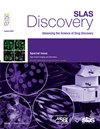RNA优化氟化片段文库的设计、合成和筛选
IF 2.7
4区 生物学
Q2 BIOCHEMICAL RESEARCH METHODS
引用次数: 0
摘要
基于片段的筛选是早期药物发现的有效方法。在这项研究中,我们的目标是创建一个片段文库,以优化对RNA靶标的高命中率。RNA在历史上一直是一个未被充分开发的目标,但最近的研究表明,优化RNA结合的小分子文库具有潜力。我们将这一概念扩展到片段库,以产生RNA优化的氟化片段库。然后,我们筛选了这个文库,以及两个非RNA优化片段文库,针对三个RNA靶标:人类细胞质a位点和酿酒葡萄球菌tRNAAsp反密码子干环,有和没有核碱基修饰。屏幕分别对各自的目标进行了24次、31次和20次命中。重要的是,统计分析证实了在我们的RNA优化文库中有显著的高命中率。基于这些发现,我们提出了开发RNA优化片段文库的指导方针。我们希望该指南将有助于加快基于片段的RNA靶点配体的发现,并有助于将RNA作为药物发现的有希望的靶点。本文章由计算机程序翻译,如有差异,请以英文原文为准。

Design, synthesis, and screening of an RNA optimized fluorinated fragment library
Fragment-based screening is an efficient method for early-stage drug discovery. In this study, we aimed to create a fragment library optimized for producing high hit rates against RNA targets. RNA has historically been an underexplored target, but recent research suggests potential for optimizing small molecule libraries for RNA binding. We extended this concept to fragment libraries to produce an RNA optimized fluorinated fragment library. We then screened this library, alongside two non-RNA optimized fragment libraries, against three RNA targets: the human cytoplasmic A-site and the S. cerevisiae tRNAAsp anticodon stem loop with and without nucleobase modifications. The screens yielded 24, 31, and 20 hits against the respective targets. Importantly, statistical analysis confirmed a significant overrepresentation of hits in our RNA optimized library. Based on these findings, we propose guidelines for developing RNA optimized fragment libraries. We hope the guidelines will help expediting fragment-based ligand discovery for RNA targets and contribute to presenting RNA as a promising target in drug discovery.
求助全文
通过发布文献求助,成功后即可免费获取论文全文。
去求助
来源期刊

SLAS Discovery
Chemistry-Analytical Chemistry
CiteScore
7.00
自引率
3.20%
发文量
58
审稿时长
39 days
期刊介绍:
Advancing Life Sciences R&D: SLAS Discovery reports how scientists develop and utilize novel technologies and/or approaches to provide and characterize chemical and biological tools to understand and treat human disease.
SLAS Discovery is a peer-reviewed journal that publishes scientific reports that enable and improve target validation, evaluate current drug discovery technologies, provide novel research tools, and incorporate research approaches that enhance depth of knowledge and drug discovery success.
SLAS Discovery emphasizes scientific and technical advances in target identification/validation (including chemical probes, RNA silencing, gene editing technologies); biomarker discovery; assay development; virtual, medium- or high-throughput screening (biochemical and biological, biophysical, phenotypic, toxicological, ADME); lead generation/optimization; chemical biology; and informatics (data analysis, image analysis, statistics, bio- and chemo-informatics). Review articles on target biology, new paradigms in drug discovery and advances in drug discovery technologies.
SLAS Discovery is of particular interest to those involved in analytical chemistry, applied microbiology, automation, biochemistry, bioengineering, biomedical optics, biotechnology, bioinformatics, cell biology, DNA science and technology, genetics, information technology, medicinal chemistry, molecular biology, natural products chemistry, organic chemistry, pharmacology, spectroscopy, and toxicology.
SLAS Discovery is a member of the Committee on Publication Ethics (COPE) and was published previously (1996-2016) as the Journal of Biomolecular Screening (JBS).
 求助内容:
求助内容: 应助结果提醒方式:
应助结果提醒方式:


